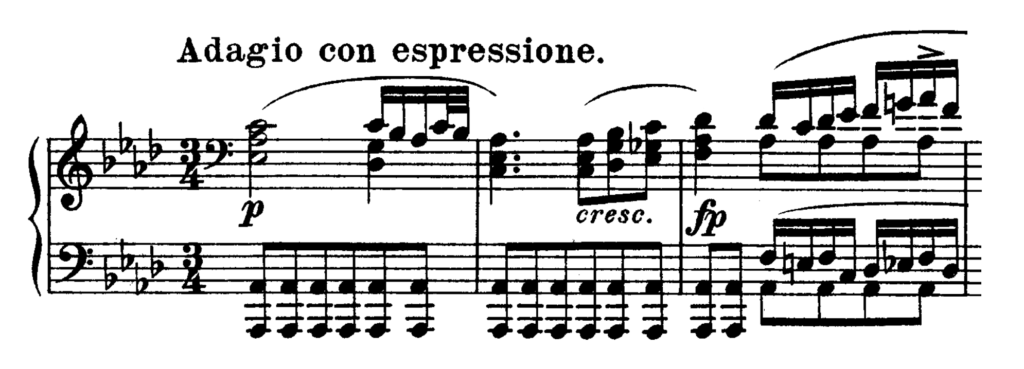Analysis
Contents
For the benefit of all pianists learning this work, we present to you a concise and easy to use analysis of Beethoven’s Piano Sonata No.13 in Eb major “Quasi una fantasia”
First Movement (Andante-Allegro)
Form: Ternary Form. Eb Major.
This is the second Sonata of which the first movement is not in Sonata form, the first instance under our notice being Op. 26.
FIRST PART:
Bars 1-9: First Subject in E flat major (tonic). The first subject consists of two complete sentences in E flat major of four bars each – both of which are repeated.
Bars 9-22: Episode. The episode, like the first subject, begins and ends in the key of the tonic, it modulates, Bars 15-16, to F minor, Bars 15-18 are repeated (slightly varied), Bars 19-22.
Bars 23-38: First Subject (varied).
SECOND PART:
Bars 39-66: Episode in C major. This episode commences with an eight-bar section, ending in the key of G major, Bar 47 (double bar and repeat from Bar 39), followed by another eight-bar section (founded upon the above), with a varied repetition of the same, leading into the key of the tonic E flat.
THIRD PART:
Bars 67-82: Repetition of first subject (varied).
Bars 83-End: Coda.
Second Movement (Allegro Molto E Vivace)
Form: Ternary Form. C Minor.
FIRST PART:
The First Part is in Simple Binary form.
Bars 1-16: First Subject begins in C minor (tonic), ends in G minor.
Double bar and repeat.
Bars 18-26: Episode. The episode is formed upon the first subject.
Bars 27-45: First Subject (varied) in original key, altered so as to end in C minor (tonic).
Double bar and repeat from Bar 20.
SECOND PART:
Bars 45-61: Subject beings in A flat major and ends in E flat major.
Double bar and repeat from Bar 46.
Bars 62-80: Episode. This episode is entirely formed upon the chord of the dominant ninth, the rhythm being the same as in the preceding part.
THIRD PART:
Bars 82-137: Repetition of Part I (varied and extended).
Bars 137-149: Coda.
Third Movement (Adagio Con Espressione)
Form: Ternary Form. Ab Major.
This movement may be considered an introduction to the fourth movement.
FIRST PART:
Bars 1-8: First Subject in A flat major (tonic). The first subject ends on a half-close on the dominant.
SECOND PART:
Bars 8-16: Episode. This episode begins and ends in the key of the dominant. In the concluding bar (16) there is a modulation back to the tonic key
THIRD PART:
Bars 17-24: First Subject (varied) in original key.
Bars 24-26: Bars 24-26 constitute a cadenza leading into the fourth movement.
Fourth Movement (Allegro Vivace)
Form: Rondo Form. Eb Major.
FIRST PART:
Bars 1-25: First Subject in E flat major (tonic). The first subject begins with a four-bar section ending in dominant key, which is repeated (altered), ending in tonic key, forming a complete sentence of eight bars; Bars 10-17 form another sentence of eight bars; Bars 18-25 are a repetition of Bars 10-17.
Bars 25-36: Episode. This episode is formed upon the beginning of the first subject.
Bars 36-73: Second Subject in B flat major. The second subject is in two parts, both begin and end in the key of the dominant, Bars 36-57 and 57-73.
Bars 73-83: Episode. This episode is formed on dominant pedal point, modulating to tonic key.
Bars 83-98: First Subject in original key.
Bars 99-107: Bars 99-107, constructed on the first subject, being in the key of the tonic minor and end in G flat major; they are preparatory to the second part (development), which begins in that key.
SECOND PART:
Bars 107-167: Development. The second part consists of a working out of the first subject (Bars 107-140), followed (Bars 140-167) by a passage leading to the third entry of the first subject.
THIRD PART:
Bars 167-191: First Subject in original key. The repetition of part of the first subject already referred to r-appears here inverted, Bars 194-191.
Bars 191-204: Episode. This episode begins like the first, which it imitates exactly for four bars, after which it modulates and ends on dominant, Bar 204.
Bars 204-241: Second Subject in E flat major (tonic).
Bras 241-256: Episode. This episode resembles the second episode in Part I. It begins in the key of A flat major, and ends on dominant seventh, Bar 256.
Bars 257-End: Coda. The Coda reverts to the third movement transposed into E flat (Introduction to the fourth movement), after a cadenza it closes “Presto,” Bar 267 to the end, formed upon the second and third notes of the first subject.










